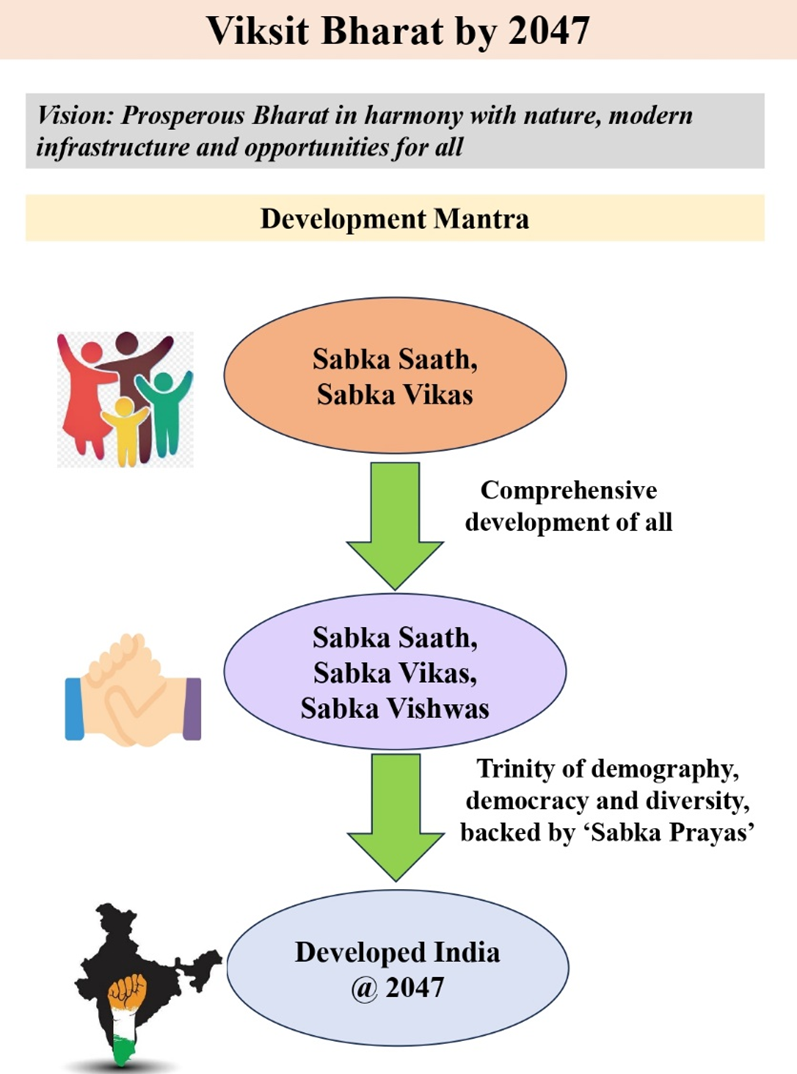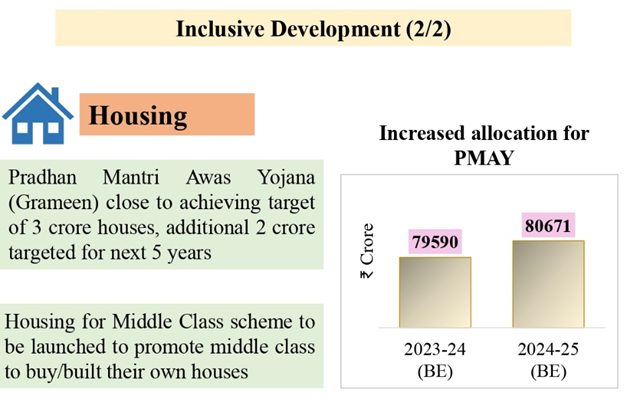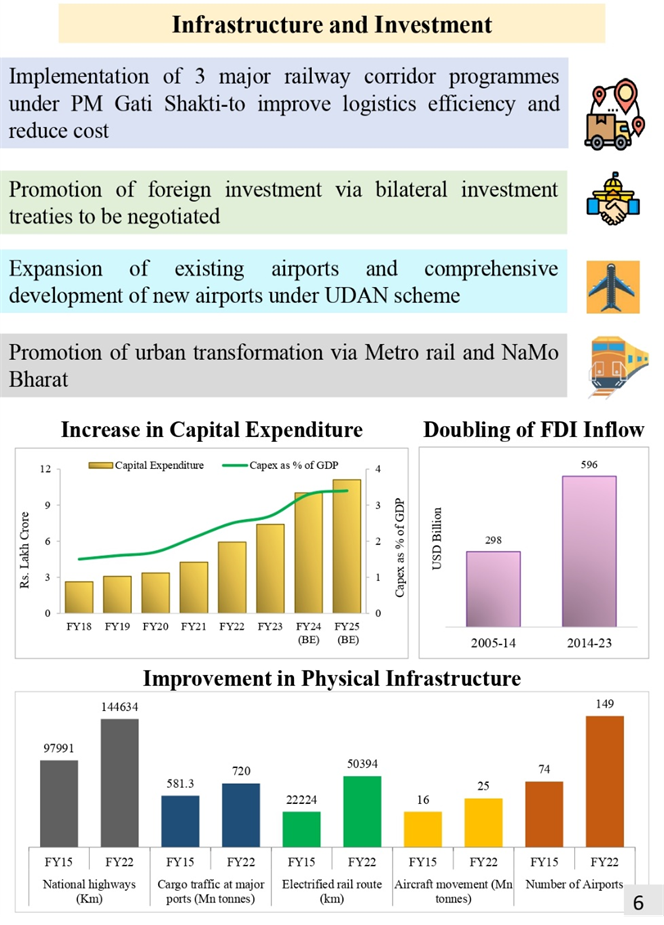PART-A
With the ’mantra of ’Sabka Saath, Sabka Vikas, and Sabka Vishwas and the whole of nation approach of “Sabka Prayas”, the Union Minister for Finance and Corporate Affairs Smt. Nirmala Sitharaman presented the Interim Union Budget 2024-25 in Parliament.
The key
highlights of the Budget are as follows:
‘Garib Kalyan, Desh ka Kalyan’
·
Over the past 10 years, the government has
assisted 25 crore people in escaping multi-dimensional poverty.
·
The government has utilized PM-Jan Dhan
accounts for Direct Benefit Transfer (DBT) of Rs. 34 lakh crore, resulting in
savings of Rs. 2.7 lakh crore.
·
PM-SVANidhi has provided credit assistance to
78 lakh street vendors, with 2.3 lakh receiving credit for the third time.
·
PM-JANMAN Yojana has been implemented to aid
the development of particularly vulnerable tribal groups (PVTG).
· PM-Vishwakarma Yojana provides end-to-end support to artisans and craftspeople engaged in 18 trades.
Welfare of ‘Annadata’
- The PM-KISAN SAMMAN Yojana has supported 11.8
crore farmers with financial assistance.
- The PM Fasal BimaYojana has provided crop insurance to 4 crore farmers.
- The Electronic National Agriculture Market (e-NAM) has integrated 1361 mandis and served 1.8 crore farmers.
- The trading volume of e-NAM has been around Rs. 3 lakh crore.
Reforms in the States for Viksit Bharat’
Housing
- The government is launching a scheme to assist deserving middle-class individuals who are currently residing in rented houses, slums, chawls or unauthorized colonies to purchase or construct their own homes.
- Rooftop solarization and muft bijli: Additionally, the government plans to provide rooftop solarization and
muft bijli, which will enable approximately 1 crore households to receive up to
300 units of free electricity each month. This scheme is in line with the Prime
Minister's commitment made on the historic day of the consecration of Ram
Mandir in Ayodhya, as stated by the Finance Minister. Each household is
expected to save between Rs. 15000 to Rs. 18000 per year.
- PM Awas Yojana (Grameen) (PMAY-G): Furthermore, the PM Awas Yojana (Grameen) (PMAY-G) plans to take up two crore additional houses in the next five years to meet the growing need for housing as the number of families increases.
Health
- The government is taking steps to prevent cervical cancer by providing vaccination to girls between the ages of 9 and 14.
- To improve medical facilities, the government is planning to establish more medical colleges by using the existing hospital infrastructure under various departments.
- The upgradation of anganwadi centers under the "Saksham Anganwadi and Poshan 2.0" scheme will be expedited.
- The U-WIN platform for managing immunization and intensified efforts of Mission Indradhanush will be rolled out quickly.
- Additionally, all ASHA workers, Anganwadi Workers, and Helpers will be covered under the Ayushman Bharat scheme.
Agriculture and related sectors
The following are some key initiatives and
programs aimed at promoting agriculture and food processing, enhancing crop
productivity, achieving self-sufficiency in oil seeds, supporting dairy
farmers, and boosting aquaculture productivity:
- Promotion of private and public investment
in post-harvest activities, including aggregation, modern storage, efficient
supply chains, primary and secondary processing, and marketing and branding.
- Expansion of the application of Nano DAP on
various crops in all agro-climatic zones.
- Formulation of a strategy called Atmanirbhar
Oil Seeds Abhiyan to achieve self-sufficiency in oil seeds such as mustard,
groundnut, sesame, soybean, and sunflower.
- Formulation of a comprehensive program to
support dairy farmers, building on the success of existing schemes such as
Rashtriya Gokul Mission, National Livestock Mission, and Infrastructure
Development Funds for dairy processing and animal husbandry.
- Stepping up the implementation of Pradhan
Mantri Matsya Sampada Yojana (PMMSY) to enhance aquaculture productivity from
the existing 3 to 5 tons per hectare, double exports to 1 lakh crore, and
generate 55 lakh employment opportunities in the near future. Additionally,
five integrated aquaparks will be set up.
Women
- The target of Lakhpati Didi has been
increased from 2 crore to 3 crore.
- A vaccination program has been launched to
prevent cervical cancer for girls aged between 9 to 14 years old.
- Various schemes for maternal and child care
have been combined to create one comprehensive program. The upgrading of
Anganwadi Centres under 'Saksham Anganwadi and Poshan 2.0' will be expedited.
Youth And Technology
A corpus of Rs. 1 lakh crore will be
established with a fifty-year interest-free loan to provide long-term financing
or refinancing with long tenors and low or zero interest rates.
Additionally, a new scheme will be launched to
strengthen deep-tech technologies for defence purposes and accelerate
'atmanirbharta'.
Infrastructure Development
Capital expenditure outlay for Infrastructure
development and employment generation to be increased by 11.1 per cent to
Rs.11,11,111 crore, that will be 3.4 per cent of the GDP.
Railways
Under the PM Gati Shakti initiative, three key
railway corridor programmes have been identified to enhance logistics
efficiency and reduce costs:
- Energy, mineral, and cement corridors
- Port connectivity corridors
- High traffic density corridors
As part of this effort, 40,000 regular rail
bogies will be upgraded to meet Vande Bharat standards. The expansion of Metro
and NaMO Bharat will be actively supported in major cities, with a focus on
transit-oriented development.
Aviation Sector
- In the aviation sector, the number of airports in the country has doubled to reach 149.
- A total of 517 new routes have been established, catering to 1.3 crore passengers.
- Indian carriers have made significant investments by placing orders for over 1,000 new aircraft.
Environment and Green Energy
- The government is launching a new scheme called Blue Economy 2.0, which aims to restore and adapt coastal areas and promote aquaculture and mariculture with an integrated and multi-sectoral approach.
- Furthermore, the government is providing viability gap funding for harnessing offshore wind energy potential, with an initial capacity of one giga-watt. This will help to reduce the need for imports of natural gas, methanol, and ammonia.
- In addition, a coal gasification and liquefaction plant with a capacity of 100 MT will be set up by 2030, which will further contribute to reducing the need for imports of natural gas, methanol, and ammonia.
- The government is also mandating phased mandatory blending of compressed biogas (CBG) in compressed natural gas (CNG) for transport and piped natural gas (PNG) for domestic purposes.
- Moreover, the government is launching a new scheme for bio-manufacturing and bio-foundry, which will provide environment-friendly alternatives such as biodegradable polymers, bio-plastics, bio-pharmaceuticals and bio-agri-inputs. Financial assistance will also be provided for the procurement of biomass aggregation machinery.
- Lastly, the government is encouraging the greater adoption of e-buses for public transport networks through a payment security mechanism and support for manufacturing and charging infrastructure.
Tourism
- The government is encouraging states to comprehensively develop their iconic tourist destinations, and to focus on branding and marketing them on a global scale. To this end, a framework will be established to rate these tourist centers based on the quality of their facilities and services.
- The states will be provided with long-term, interest-free loans to finance such developments on a matching basis.
- Additionally, for domestic tourism, projects for port connectivity, tourism infrastructure, and amenities will be undertaken on our islands, including Lakshadweep.
Investments
- The FDI inflow during 2014-23 was USD 596 billion marking a golden era. That is twice the inflow during 2005-14.
- For encouraging sustained foreign investment– Negotiating bilateral investment treaties with the foreign partners, in the spirit of ‘first develop India’.
#upsc#hpas#hasallied#news#budget2024-2025#economy#india#upscnotes#currentaffairs



















Post a Comment